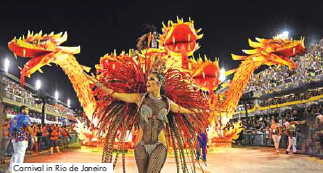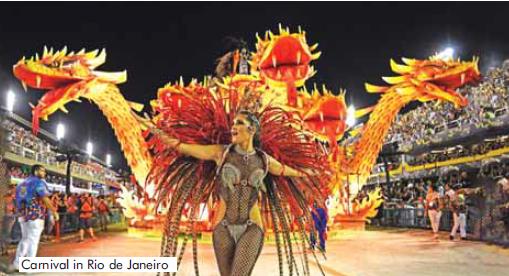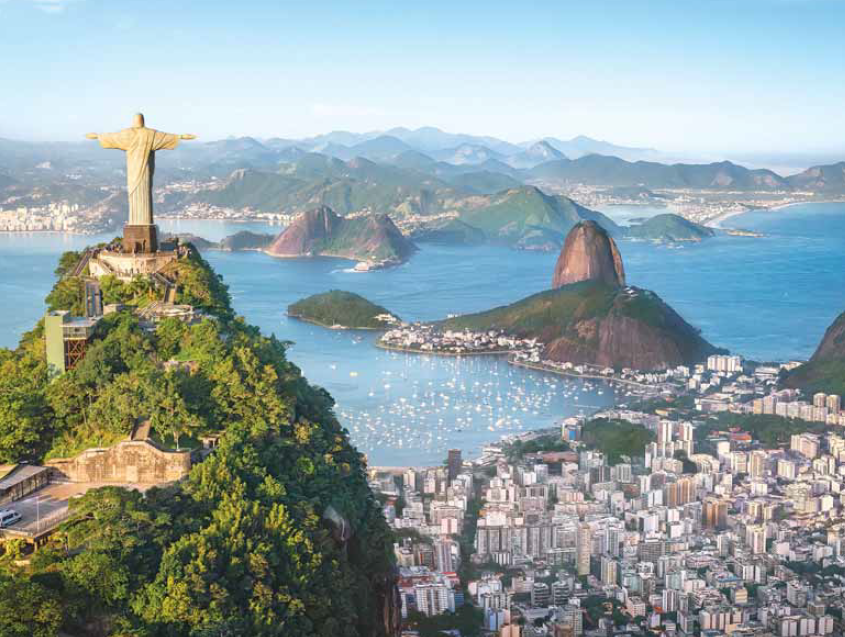There is an abundance to see and do in Brazil. Here are eight must-visit destinations in this Latin American paradise:
Rio de Janeiro
With over 450 years of history, Rio de Janeiro is a unique city that beautifully combines its geographic features—such as the sea, mountains, and forests—with vibrant human presence. To truly experience the energy of Brazilian culture, nothing compares to enjoying Carnival in Rio. Among the city’s most famous attractions are Sugarloaf Mountain, Christ the Redeemer, and Tijuca National Park. The Sugarloaf Cable Car, which operates at an altitude of 396 meters above sea level, connects Urca Mountain to Sugarloaf Mountain. Christ the Redeemer, with its open arms over Guanabara Bay, stands majestically on top of Corcovado Mountain, making it the largest and most renowned Art Deco sculpture in the world.

Commonly known as Sampa, São Paulo is a city that never sleeps. From theatrical performances and cultural exhibits to 24-hour bars and restaurants, visitors can always find something to do. The city shares its name with the state and boasts countless movie theatres, cultural centres, museums, historic buildings, parks, theatres, and art galleries. São Paulo’s nightlife is frenetic, creative, and inclusive, earning it a place among CNN’s list of the ten best places in the world for parties and nightlife. Additionally, the city is regarded as the Latin American capital of fine cuisine, featuring high-end international restaurants and sophisticated regional dishes crafted by renowned Brazilian chefs.
Belém

Belém, the capital of Pará, is a charming destination known for its beaches, forests, and historic heritage as well as modern tourist attractions. One of Belém’s main local highlights is a cultural complex called Estação das Docas (Wharf Station), which offers a variety of local cuisine, culture, fashion, and handicrafts. Visitors can enjoy performances of the carimbó, a traditional dance with Indigenous and African roots. As Belém is situated in the Amazon region, adventure seekers can explore trails in the forest or take boat rides to discover other beautiful beaches and islands in the region, such as Marajó, an island renowned for its natural beauty.
Manaus

Nestled in the heart of the Amazon Forest, Manaus is a city that boasts stunning architecture from the Rubber Boom era. The Amazonas Theatre, with its colourful dome adorned with 36,000 enamelled ceramic tiles, is a standout attraction. As the capital of Amazonas, Manaus serves as the main metropolitan hub of the region and is the natural gateway for exploring the Amazon Forest. Boats are the primary means of transportation to rainforest hotels and to witness the confluence of the Rio Negro and Solimões Rivers. Visitors can also observe Amazon River dolphins in Anavilhanas and visit places such as Moon Beach. Experience local gastronomy while touring the vast rivers and narrow streams that connect to riverside communities.
Foz do Iguaçu

In addition to the incredible Iguaçu Falls, Foz do Iguaçu boasts several attractions that will surely captivate you. Located in the extreme west of the State of Paraná, it is one of the icons of Brazilian tourism, thanks to the 275 majestic waterfalls that make up Iguaçu Falls. Situated in Iguaçu National Park, on the border between Brazil and Argentina, these Falls attract millions of visitors from around the world. Having earned a spot on the UNESCO World Natural Heritage List, the park’s stunning waterfalls were also voted one of the ‘World’s New Seven Wonders of Nature.’ Lonely Planet describes it as one of the top ten must-see places in the world, stating, “It’s an emotionally jaw-dropping experience. Everyone should see it at least once in their lifetime!”
Brasília

Brasília, Brazil’s third capital city, was planned just over 60 years ago, and its beauty lies in its intricate details, designs, and colours. Following Salvador and Rio de Janeiro, this audacious project has become a symbol of urban planning and modern architecture in the 20th century. Home to more than three million people, Brasília’s design, known as the Pilot Plan (Plano Piloto), was conceived by urban planner Lúcio Costa and architect Oscar Niemeyer. The layout resembles the shape of an aeroplane and has been included on UNESCO’s World Cultural Heritage List. Notably, Brasília is the city with the largest area on the Heritage List in the world. Its architecture stands apart from anything you have ever seen.
Fortaleza

Fortaleza, the capital city of Ceará in northeastern Brazil, has something for everyone. In addition to its countless stunning beaches, the city boasts a rich culture, delicious local cuisine, wonderful handicrafts, and beautiful architecture. Fortaleza offers various leisure options, including museums, theatres, handicraft markets, and a vibrant nightlife. Iracema Beach is a lively area where culture thrives, featuring movie theatres, a planetarium, and the Museum of Contemporary Art at the Dragão do Mar Centre of Culture and Arts. It becomes a bustling hub in the evenings with numerous bars, nightclubs, and live music. Visit the Central Market to take home an authentic souvenir from the city.
Salvador

The capital of the State of Bahia, Salvador, is renowned for its natural beauty and the strong influence of African culture. The Historic Centre of Salvador is where visitors can explore streets and architectural monuments dating back to Colonial Brazil, the Empire, and the First Republic. This culturally rich area includes the neighbourhoods of Sé, Pilar, and Pelourinho, which house historical monuments from the 17th, 18th, and 19th centuries. It is a popular destination for tourists seeking museums, theatres, churches, musical performances, local cuisine, and handicrafts. Salvador is home to more than 300 churches, including the São Francisco Church and Convent, classified as one of the Seven Wonders of Portuguese Origin in the World, and listed on the National Institute of Historic and Artistic Heritage List.






